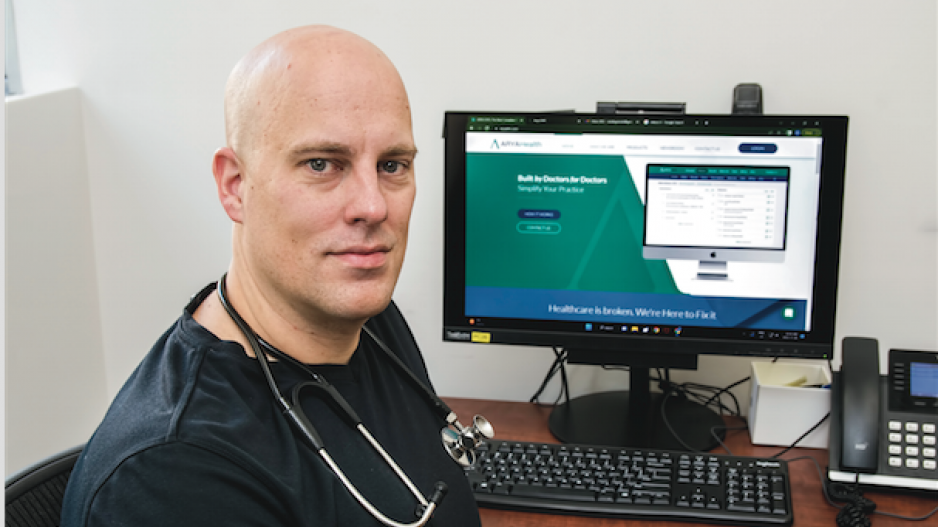Back in the 1960s, a teenaged Brian May wasn’t satisfied with the electric guitars on the market. The instruments were still relatively new and much too expensive for the future guitarist of Queen.
So May and his father, an electrical engineer, built one themselves.
For cardiologist Dr. Richard Vandegriend and his fellow co-founders at Arya Electronic Health Records, it was the same principle that drove them to develop an electronic medical records (EMR) service – with help from a technical team – meant to compete with the major players.
“We’re physicians. We’ve been using these sorts of products and they’re all terrible,” said Vandegriend.
EMRs function as digital versions of the paper charts doctors rely on for patient histories, diagnoses and prescriptions.
Despite the market entry of upstarts like Arya, challenges remain in scaling up the use of these records owing to both regulatory hurdles and interoperability issues.
“Allowing clinicians to chart the way they want has always faced tension with the need for EHRs [electronic health records] to satisfy other requirements (e.g., billing and regulatory reporting),” an October report from international business services firm Deloitte Ltd. concluded. “EHRs and patient portals are not intuitive enough, and improvements are needed for both clinicians and consumers. Clinicians in particular find documentation burdensome.”
Health care falls within the domain of provinces, meaning there is no universal set of regulatory protocols governing privacy and security across Canada.
EMR providers must tailor their products to the jurisdictions in which they’re providing those services.
And even within B.C., EMRs are not necessarily interoperable between health regions.
For example, the Fraser Health Authority uses Medical Information Technology Inc. (Meditech) for EHR services, while Vancouver Coastal Health uses a system known as CST Cerner.
To bridge that gap between different health regions, health-care professionals must use a system called CareConnect.
“But it doesn’t always work as designed,” Vandegriend said.
Rather than targeting hospitals, Arya’s team is targeting smaller outpatient clinics. The EMRs Arya has developed can also be applied to dentists and physiotherapists.
Vancouver-based companies like Well Health Technologies Corp. (TSX:WELL) and Telus Corp. (TSX:T), through its Telus Health subsidiary, have been consolidating much of the EMR market in Canada in recent years.
Well Health most recently closed a deal worth $5.75 million to acquire the EMR assets of Cloud Practice Inc. amid an ongoing acquisition spree. It estimates its own annual revenue will reach $565 million by year’s end.
Telus Health COO Michael Dingle, meanwhile, said adoption of EMRs has been ramping up, with 87 per cent of Canadian physicians using EMRs in 2021, up from 82 per cent in 2017, according to the Canadian Medical Association’s 2021 National Survey of Canadian Physicians.
“So we continue to see adoption of the electronic medical record as a requisite tool to find efficiency in care delivery and to deliver better experiences for both providers and for people,” Dingle told BIV.
He acknowledged some of the challenges facing wider adoption, adding that falling in line with regulatory obligations remains a top priority.
“Where privacy and security are designed into the interactions where we can provide interoperability between our own systems, of course, and then between those in the market – it’s all important,” he said. “That said, it takes time in these markets, particularly with the regulatory overlay to ensure that this was done right. And we’re committed to that.”
Dingle noted that health-care information is easier to move now compared with five years ago, but interoperability between jurisdictions is still a stumbling block.
“We need ubiquity at the regulatory level in order for there to be, if you will, one patient, one record. And so ultimately that is where we will end up, we believe, but that requires the regulator to clear the path for those that are in the provision of solutions, like we are, to allow us to have a system that operates that way,” he said. “The construct of the system at the regulatory level doesn’t allow for that.”
And from a practical perspective, Vandegriend said the adoption of more efficient tools needs to accelerate.
“Health care is kind of in crisis right now. Burnout amongst medical staff is at an all-time high. We’re having trouble staffing the hospitals,” he said. “We’ve basically automated a lot of paperwork that has been sort of drowning health-care providers to date.”




